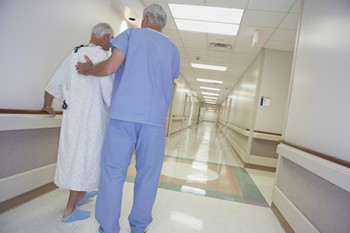After a Stroke
Disabilities that may result from a stroke
Although a stroke is an injury to the brain, it can affect the entire body. In many cases, a stroke weakens the muscles, making it hard to walk, eat, or dress without help. Some symptoms may improve with time and rehabilitation or therapy. The effects of a stroke range from mild to severe and depend upon which area of the brain is damaged. Generally, a stroke can affect five basic areas:
Movement
 Paralysis and/or problems controlling movement are among the most common disabilities resulting from stroke. The paralysis is usually on one side of the body and, depending on the severity, can affect mobility, coordination and balance, along with activities of daily living.
Paralysis and/or problems controlling movement are among the most common disabilities resulting from stroke. The paralysis is usually on one side of the body and, depending on the severity, can affect mobility, coordination and balance, along with activities of daily living.
Senses & Pain
Sensory disturbances occur when patients lose the ability to feel touch, pain, temperature or position, and can affect the body's functioning, including bowel or bladder control. Stroke survivors frequently have a variety of chronic pain syndromes resulting from stroke-induced damage to the nervous system.
Language
At least one-fourth of all stroke survivors experience language impairments, involving the ability to speak, write and understand spoken and written language. A stroke-induced injury to any of the brain's language-control centers can severely impair verbal communication.
Thinking & Memory
 Stroke can cause damage to parts of the brain responsible for memory, learning and awareness. Stroke survivors may have dramatically shortened attention spans or deficits in short-term memory and may lose their ability to make plans, comprehend meaning, learn new tasks or engage in other complex mental activities.
Stroke can cause damage to parts of the brain responsible for memory, learning and awareness. Stroke survivors may have dramatically shortened attention spans or deficits in short-term memory and may lose their ability to make plans, comprehend meaning, learn new tasks or engage in other complex mental activities.
Emotions
Many people who survive a stroke feel fear, anxiety, frustration, anger, sadness and a sense of grief over their physical and mental losses. While these feelings are a natural response to the psychological trauma of stroke, some emotional disturbances and personality changes are caused by the physical effects of brain damage. Physicians and counselors may be able to help alleviate these symptoms through counseling, behavior modification and/or medication.
Strokes in the brain stem are very harmful because the brain stem controls all our body's functions that we don't have to think about, such as eye movements, breathing, hearing, speech, and swallowing. Since impulses that start in the brain must travel through the brain stem on their way to the arms and legs, patients with a brain stem stroke may also develop paralysis, or not be able to move or feel on one or both sides of the body.
Sources: www.nih.gov and www.cdc.gov
Recovery & Rehabilitation
More than seven million people in the United States who have survived a stroke or brain attack and are living with the after-effects. According to the National Stroke Association, general recovery guidelines show:
- 10 percent of stroke survivors recover almost completely
- 25 percent recover with minor impairments
- 40 percent experience moderate to severe impairments requiring special care
- 10 percent require care in a nursing home or other long-term care facility
- 15 percent die shortly after the stroke
Rehabilitation starts in the hospital as soon as possible after the stroke and should be continued as necessary after release from the hospital. Depending on the severity of the stroke, rehabilitation options include:
- A rehabilitation unit
- A sub-acute care unit
- A rehabilitation hospital
- Home health services
- Home with outpatient therapy
- A long-term care facility that provides therapy and skilled nursing care
 The goal in rehabilitation is to improve function so that the stroke survivor can become as independent as possible. For more information about recovery and rehabilitation after a stroke, please call 304.526.6317.
The goal in rehabilitation is to improve function so that the stroke survivor can become as independent as possible. For more information about recovery and rehabilitation after a stroke, please call 304.526.6317.
